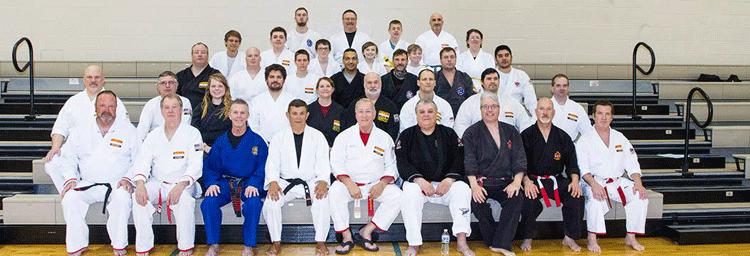The Master's Edge

Michael A. Sullenger
9th Dan
AKS Chief Instructor
. . .
|
AKS Quarterly Newsletter
"The Punchline Editorial"
June 2015
Summer has begun and with it the storms and heat here in south Texas. I recently had the honor and pleasure of being involved in a seminar with legendary American Karate Icon J. Pat Burleson. I've been familiar with this gentleman since the 1967 time frame when I used to train at one of Allen Steen's schools in Dallas. Sensei Burleson is 78 or 79 and still going. We had a great visit that culminated in a diner. He was pleasantly surprised to find he and I had much in common, to include knowing many of the same people. He voiced his sadness at the loss of his friend and fellow pioneer Ernie Lieb. I told him the senior leadership of the AKS was keeping sensei Lieb's legacy alive and well.
I had a great trip and visit in April when I traveled to Toledo for the Spring AKS Seminar hosted by Sensei Skip Palmer and his Toledo school. We had some great instructors and AKS members from West Virginia, Detroit and various locations in Michigan. As has been the case in previous seminars, it was a great weekend. Our sincere appreciation to Skip, his wife, Deb, and all the members of the Toledo AKS club.
In the past we've had a few people who have voiced a desire to join the ranks of the AKS. We welcome them with open arms. However, regardless of their style and years of training and study, they are still required to train with us in order to bring themselves up to speed with our (AKS) requirements. If a person holds a 3rd degree black belt, they must train up to our level and requirements for that rank. Once that has been achieved, they may begin working towards the next highest rank. Once they've acquired that rank, their time in grade in the AKS begins. Until, and unless this happens, the party has not fulfilled AKS requirements and may not test others in rank without those students also meeting the same criteria. I feel it's important to clarify this in the event there may have been some confusion. If there are any questions, I welcome them. You may also visit with either of the two Assistant Chief Instructors, Fred Reinecke and Dave Thomas.
In just about a month we'll be holding our annual summer camp in Muskegon. I hope you will all join us for this event during the weekend of July 17-19,2015.
Until then stay safe, keep training, and have a great summer.
Mike Sullenger, 9th Dan
AKS Chief Instructor
PS - I'm very pleased to see we have received an e-mail and testing information from one of our AKS schools in Germany. It is truly my desire to see more such contacts and inputs to our newsletter. The Punchline is all AKS members' quarterly means to stay in touch and share what's going on in your respective dojos. To the the Weyhe folks at the Tasai Dojo - welcome and congratulations.

|
A Little Wisdom

. . .
|
Are You A "Good Uke" or A "Bad Uke"?
by E. Jude Gore 6th Dan A.K.S.
Mountaineer Karate Club
Every time I ask this, I picture myself as Glinda the Good Witch of the North asking Dorothy, "Are you a good witch or a bad witch?" Now that I got that out of my system we can go back to asking, "Are you a good Uke or a bad Uke"? Now some of you may not be sure, especially if you don't know what an Uke (oo-kay) is, or at least how I use the term. In Japanese, uke means to receive. It is used in many martial arts in partner training to designate the person initiating the attack, and it allows the defender (the Tori) to demonstrate or practice his/her defense and counter. Sounds like an easy job . . . just throw the technique, your job is done and the defender takes care of the rest. However, this is far from the truth. Working with a bad Uke can result in much frustration, poor training, and most importantly - injury, most likely to Uke.
As an Uke, you should expect to be taken or thrown to the mat for some techniques. You need to know how to fall and be willing to fall. This is a skill that we as martial artists should work on regardless of the style. If you don't know how to fall and roll, take some lessons in Judo or Aikido, and practice. The techniques of the defender may include wrist locks and arm bars. Be sure to warm up and stretch all muscles and joints prior a demonstration, testing, or even when just practicing. If you have an injury or physical problem, it is your responsibility to notify your partner prior to the techniques.  To notify them after an arm bar that you have a torn rotator cuff is too late. In my Aikido class, there is a very good student that has a very bad shoulder. Most likely surgery is in the future. He wears a red band on that arm to help remind us that we need to take special precautions when working on that side. The Uke should react by simulating what would happen if the defender had used the technique with full speed and force. If I am kicked or punched in the stomach, I lean forward. A strike to my face tilts my head rearward. The Uke must be willing to allow his partner to demonstrate and practice his techniques without active resistance. Too many times an Uke has gotten hurt from resisting. In a demonstration or testing, an uncooperative Uke makes the defender look bad. It causes the defender to put more force and speed behind his technique to show that it works and injuries can occur. The Uke should also not take for granted that the Tori is done until he/she hears a Kiai and the defender steps back and away. To notify them after an arm bar that you have a torn rotator cuff is too late. In my Aikido class, there is a very good student that has a very bad shoulder. Most likely surgery is in the future. He wears a red band on that arm to help remind us that we need to take special precautions when working on that side. The Uke should react by simulating what would happen if the defender had used the technique with full speed and force. If I am kicked or punched in the stomach, I lean forward. A strike to my face tilts my head rearward. The Uke must be willing to allow his partner to demonstrate and practice his techniques without active resistance. Too many times an Uke has gotten hurt from resisting. In a demonstration or testing, an uncooperative Uke makes the defender look bad. It causes the defender to put more force and speed behind his technique to show that it works and injuries can occur. The Uke should also not take for granted that the Tori is done until he/she hears a Kiai and the defender steps back and away.
However, part of the responsibility belongs to the defender. Your Uke must trust that you have good control and a good understanding of their strengths and weaknesses. Can your Uke fall, and if so, how well? If they cannot, it's not going to be pretty when you throw them. Do they have tight wrists? If you hurt someone, they are not going to want to come out and play. How is the Uke going to react to your techniques? If you throw a front kick to the groin followed by a front punch to the face, are they going to lean forward in reaction to the groin strike or stand straight up as if they are "Iron Cup Man"? It is always best that the defender and attacker are familiar with each other for demonstrations and testings. Many systems now require you to bring the Uke you worked with when you are tested.
There must be communication between the Uke (attacker) and the Tori (defender). When a wrist lock, arm bar, or pin is being applied, the Uke needs to slap the mat, tap loudly, or verbally communicate to the defender that the technique is working. This needs to be done prior to too much pain. If the Uke waits too long, damage may occur. At our Dojo, we will say "Matte", pronounced ma-tay, which means wait. The Tori needs to also realize that some Uke's are non-responders. They do not feel pain until it is too late. So the defender must be observant and aware of non-verbal clues such as facial expressions or tension in the arm, shoulder or wrist. I was at a seminar in Virginia many years ago where an Uke was a non-responder. The instructor did not realize it and continued to apply pressure to an arm bar. The Uke's arm ended up broken. Both partners must use good judgement and communication.
So Dorothy, "Are you a good witch or a bad witch?" (Always wanted to say that).

(The views of the author are his own. Any resemblance to an intelligent person, living or dead is completely coincidental).

|
Life In The Dojo

. . .
|
Training with Mr Nehring
by Dave Thomas
On April 18, I had the privilege of working with Mr. Tom Nehring, 6th Dan Kempo, at the Toledo Seminar. He shared the philosophies and techniques of Kempo. His style traces back to Mr. Ed Parker, probably the best known Kempo Instructor in America. Mr Parker in turn was a friend of Mr. Lieb's. During the 60's, Mr. Lieb competed at his Long Beach International Karate Tournament.
The derivation and execution of techniques from other styles is always interesting and enlightening to learn. Mr. Nehring has an engaging teaching style. He teaches in a very student-friendly manner. He easily kept the students' attention between demonstrating techniques, and sharing stories and experiences.
The most memorable he shared was the time Chuck Norris visited their Toledo school during a promotional tour for one of his new movies. Tom said that Mr. Norris sat quietly and listened as the students and Black Belts bemoaned being cheated and treated unfairly at tournaments. The judges wouldn't call their points and wouldn't score them fairly in forms. It wasn't the students' fault they couldn't win. The fault was because of others.
Tom said Chuck didn't say a word during the tournament diatribe. When the students finished, Mr. Norris stood up and said, "You're right. As long as it's someone else's fault, you'll never win." Momentary silence. "What you should do is to train and compete so when you throw a punch or kick everyone in the gym sees it. If you want to win, make the problems your fault, not someone else's. Own the problem; don't pass the blame."
Wow!
I was amazed at the simplicity and the depth of his statement. While there was much more learned and shared during the Toledo Seminar, that concept alone made the trip to the seminar worth while. I knew it was the first thing I had to share with my students as soon as I returned to class.
As with most things we teach and share in American Karate, the message transcends the dojo. In a time of no accountability, lack of personal responsibility, and the litany of cultural excuses for failure; at a time when our current culture contends nothing is your fault because of others, what an enlightening concept. I can't recount the number of meetings and conversations I have had where someone complained that they were impotent because of the actions of others. "Not my fault, they wouldn't help me." Or even better, "Look what you made me do."
Very recently during a foster parent's meeting as others in the room were whining that the system was unfair and created problems they were powerless to correct, I interrupted with: "Chuck Norris would tell you, 'Own it to win it.' " The room got uncomfortably quiet after my comment.
While true, I may not be invited back to another meeting anytime soon, I won again. Thanks Chuck!
And now a little humor . . .
On the first day of the Third Grade, the teacher asked the students what scared them the most. One of our white belts replied, "H-Form."
Do You Have Member News ?
Please send news (weddings, births, graduations, etc.) so that we may share with our members and friends. Accompanying pictures are most welcome!
If you have a concern, question or suggestion, please let us know and we will address it here in the Punchline.
Please send your information to
Laura Werner
We look forward to hearing from you !
|
Promotions
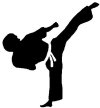
. . .
|
PROMOTIONS!!
Muskegon Community College Karate Club
Muskegon, Michigan 49442
Frederic A. Reinecke 8th Dan - Head Instructor
|
American Karate Club
Ross Park Elementary - Muskegon, MichiganDave Thomas, 8th Dan - Head Instructor
|
|
Salem Karate Club
Salem Park Barn - Moore Street - Salem, West Virginia
John Folsom 8th Dan - Head Instructor
|
Mountaineer Karate Club
Lumberport, West Virginia
E. Jude Gore 6th Dan - Head Instructor
|
West Toledo YMCA Karate & Self Defense Program
Toledo, Ohio
Rand Palmer 6th Dan - Head Instructor
|
Tri-Cities Family YMCA AKS Karate Club
Grand Haven, Michigan
Chad Smith 2nd Dan - Head Instructor
|
All-Star Karate Club
Livonia, Michigan
Jim Hope 4th Dan - Head Instructor
|
Mustang, Oklahoma A.K.S.
Mustang, Oklahoma
Jeff Johnson 1st Dan - Head Instructor
|
Tasai Dojo A.K.S.
Weyhe, Germany
Rudolf Schwalda - Head Instructor
|
Congratulations to all students who have been promoted this past quarter, and to those we've missed in prior newsletters.
And welcome to our newest Dojo from Germany. Please read the article in "AKS NEWS" below. Best wishes in your continued training!
Attention Instructors, if you have students who have been promoted, please send this information so that we may acknowledge their accomplishments.
Guest Article

. . .
|
News from the Mountain State
by E. Jude Gore 6th Dan AKS
Mountaineer Karate Club

We have had a very busy spring and early summer here in West Virginia. AKS Assistant Chief Instructor, Fred Reinecke, graciously traveled down from Michigan to head up a testing board for four Black Belt candidates.  The testing covered two nights, June 1st & 2nd, and totaled around five hours. Due to additional time available, Sensei Reinecke conducted a very thorough test which touched on many areas that we do not normally have time for. John Folsom, 8th Dan Salem Karate Club, had three students testing: James Wise, Don Riffle, and Miki Gain. The Mountaineer Karate Club had one candidate up for testing, William Way. Sensei Reinecke headed the testing board which also included John Folsom, 8th Dan, Jude Gore, 6th Dan, and Sandra Gore 2nd Dan. We are pleased to announce that all four candidates passed and the AKS has added four new Black Belts to our ranks. The testing covered two nights, June 1st & 2nd, and totaled around five hours. Due to additional time available, Sensei Reinecke conducted a very thorough test which touched on many areas that we do not normally have time for. John Folsom, 8th Dan Salem Karate Club, had three students testing: James Wise, Don Riffle, and Miki Gain. The Mountaineer Karate Club had one candidate up for testing, William Way. Sensei Reinecke headed the testing board which also included John Folsom, 8th Dan, Jude Gore, 6th Dan, and Sandra Gore 2nd Dan. We are pleased to announce that all four candidates passed and the AKS has added four new Black Belts to our ranks.

This spring, several members from the Mountaineer Karate Club became interested in participating in local tournaments. On April 25, 2015, Ethan Galicic II and his sister Savannah entered their first tournament, "Rumble on the River" held in Grafton, West Virginia. This tournament had over 200 competitors and many from other states such as Pennsylvania, Virginia and North Carolina. Ethan placed 1st in Kata, 2nd in Weapons, and 3rd in Sparring. Savannah placed 1st in Sparring and 4th in Kata. She did not compete in weapons. Savannah was also asked to participate in a non-competitive demo match with a young lady in the next oldest age group.
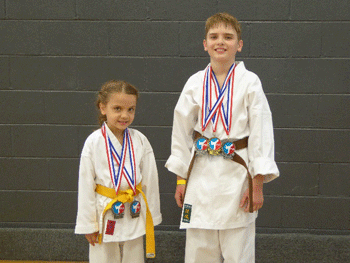
On June 7th, Ethan and Savannah competed in the "Rumble on the River Championships." Ethan again took 1st place in kata with AKS Cat Form 1, 2nd place in Weapons, and 2nd place in Sparring. If you have Facebook, please check out Ethan's Cat Form 1 on the Mountaineer Karate Club page. At this tournament, Savannah was placed in the boys division due to the fact that she just turned 6 and there were not enough girls in this age bracket. She placed 2nd in Sparring (competing against all boys) and 2nd in kata performing Tiger 1.

John Billie, also from Mountaineer Karate Club, had been practicing for this competition but badly injured his elbow at work. Mr. Billie is a police officer for the City of Shinnston, West Virginia. However, even with his injury, he decided to compete in Kata and Weapons. John, with a bandaged up arm, still placed 2nd in Kata and 3rd in Weapons. I believe this is the attitude and spirit that Mr. Lieb wanted to instill in all the AKS.
Congratulations to everyone for a job well done!

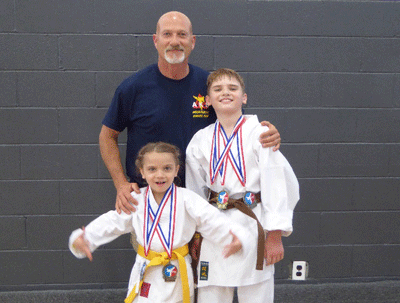
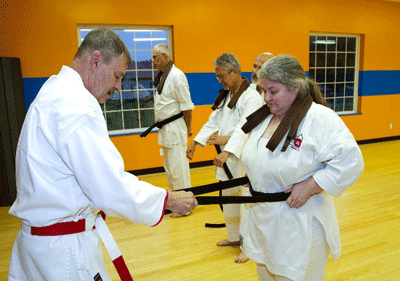
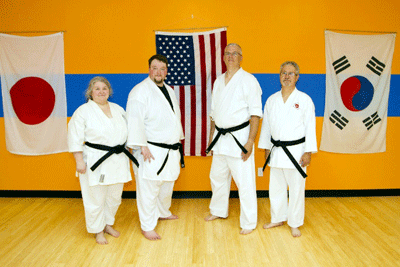
We thank those who have contributed articles to our newsletter. We encourage anyone who would like to contribute to this "quarterly" space to submit your article to: werner.lj@gmail.com
|
The News

. . .
|
A.K.S. News . . .
2015 AKS Summer Camp - July 17th - 19th
Summer Camp is always a great time to get with other A.K.S. members and guests to learn new techniques, brush up on the old, and celebrate with friends. On Saturday afternoon, the training is open to all styles. We look forward to seeing you all and to working with any who wish to join us during our afternoon session.
Congratulations to our newest black belts!
 |
Miki Gain 1st Dan A.K.S.
Salem Karate Club
Salem, West Virginia |
 |
Don Riffle 1st Dan A.K.S.
Salem Karate Club
Salem, West Virginia |
 |
William Way 1st Dan A.K.S.
Mountaineer Karate Club
Lumberport, West Virginia |
 |
James Wise 1st Dan A.K.S.
Salem Karate Club
Salem, West Virginia |
Tournament News
 |
Kristyn Reinecke participated in a tournament on May 16, 2015.
She placed:
- 1st in Weapons
- 1st in Women's Fighting
- 2nd in Open Hand
- 3rd in Men's Fighting
|
 |
Rumble on the River
April 25, 2015
Grafton, West Virginia
Ethan Galicic II placed:
- 1st in Kata
- 2nd in Weapons
- 3rd in Sparring
Savannah Galicic placed:
- 1st in Sparring
- 4th in Kata
|
 |
Rumble on the River Championship
June 7, 2015
Ethan Galicic II placed:
- 1st in Kata
- 2nd in Weapons
- 2nd in Sparring
Savannah Galicic placed:
- 2nd in Sparring (in boys division)
- 2nd in Kata
|
CONGRATULATIONS to all who competed in tournaments this past quarter!! Keep up the good work, AKS!
A.K.S. Friends in Germany
A while back I received an email from Rudolf Schwalda an A.K.S. Karateka in Germany. We are most happy to honor his request as well as post the promotions in our Punchline Newsletters. His email from April 19th states:
* * * * * * * * * * *
Dear Ms. Werner
First, I have to apologize my bad english, and the mistakes, which surely will occur. Let me
explain the reason for this mail.
I'm a AKS Karateka from Germany. I've started very late in the Age of 40 with Karate. And one of my very first larger Karate seminars were in Holzminden / Germany, when Ernest Lieb and other Member of AKS USA visited Germany. The seminar was really very impressive to me.
Now, 12 Years later, I'm running the Tasai Dojo in Weyhe, Germany as head instructor. Trying to "infect" my students with my fascination of this Karate style. So I'm sometimes reading the punchline, to get an impression of the AKS in the U.S. It's really a pity, that both countries are too far away from each other to stay in frequent contact. And today, when I read the promotions in the last Punchline, I decided to send you our last promotions in our Dojo in Germany. O.K., no black or brown belts, only up to the 4th Kyu, but also members of the AKS Karate.
It would be very nice, if you would use them for the next edition of the punchline.
Yours sincerely
Rudolf Schwalda Email
Tasai Dojo Weyhe
www.karate-sc-weyhe.de
Tasai Dojo Kyu Listing >>> .PDF document
* * * * * * * * * * *
Welcome Rudolf, and welcome Tasai Dojo in Weyhe, Germany.

AKS Recognition Page
Please take a moment to view our website and visit the A.K.S. Recognitions page. We are proud of all of our A.K.S. members who have been honored and recognized for their accomplishments and dedication to the American Karate System. It is only fitting that we honor them and thank them for their dedication and service to our organization. Ernie would be proud!
2015 Black Belt Membership Dues
All membership dues should be current. Please contact your instructor for the forms if you still need to register. Or you may fill out the appropriate forms found at the bottom of the - Calendar of Events Page.
PLEASE VISIT US ON EITHER OF OUR A.K.S. FACEBOOK PAGES AT
AKS Facebook Fan Page
AKS Facebook Group
| |
|
SUMMER Fun Time!Time for something NEW from our AKS apparel shop.
We have jackets, fleece, wind breakers, vests, shirts, sweatshirts, caps and more. There is also an embroidery service to have the AKS Logo embroiderd on your item.
We would like to thank all those who have purchased AKS apparel through our on-line store. The AKS receives a portion of the purchase price on every item sold. Thank you for your continued support.
Please visit our A.K.S. Online Store
|


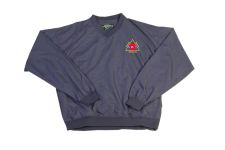


We are happy to announce we have upgraded the software to include FedEx online shipping rate calculation for International Sales. This makes it possible for us to take orders and ship to International customers.
You can reach us here . . .
A.K.S. Web Address(es)
Our "Official" web address is now: www.aks-usa.com
We also own: www.aks-usa.org and www.aks-usa.net which will direct you to our website as well.
You can also type in www.aks-usa.info and you will be taken directly to our "About Us" web page. Please check us out!!
The Punchline is published on a quarterly basis in March, June, September and December.
All rights reserved by the American Karate System℠
|
| | |












 To notify them after an arm bar that you have a torn rotator cuff is too late. In my Aikido class, there is a very good student that has a very bad shoulder. Most likely surgery is in the future. He wears a red band on that arm to help remind us that we need to take special precautions when working on that side. The Uke should react by simulating what would happen if the defender had used the technique with full speed and force. If I am kicked or punched in the stomach, I lean forward. A strike to my face tilts my head rearward. The Uke must be willing to allow his partner to demonstrate and practice his techniques without active resistance. Too many times an Uke has gotten hurt from resisting. In a demonstration or testing, an uncooperative Uke makes the defender look bad. It causes the defender to put more force and speed behind his technique to show that it works and injuries can occur. The Uke should also not take for granted that the Tori is done until he/she hears a Kiai and the defender steps back and away.
To notify them after an arm bar that you have a torn rotator cuff is too late. In my Aikido class, there is a very good student that has a very bad shoulder. Most likely surgery is in the future. He wears a red band on that arm to help remind us that we need to take special precautions when working on that side. The Uke should react by simulating what would happen if the defender had used the technique with full speed and force. If I am kicked or punched in the stomach, I lean forward. A strike to my face tilts my head rearward. The Uke must be willing to allow his partner to demonstrate and practice his techniques without active resistance. Too many times an Uke has gotten hurt from resisting. In a demonstration or testing, an uncooperative Uke makes the defender look bad. It causes the defender to put more force and speed behind his technique to show that it works and injuries can occur. The Uke should also not take for granted that the Tori is done until he/she hears a Kiai and the defender steps back and away.

 The testing covered two nights, June 1st & 2nd, and totaled around five hours. Due to additional time available, Sensei Reinecke conducted a very thorough test which touched on many areas that we do not normally have time for. John Folsom, 8th Dan Salem Karate Club, had three students testing: James Wise, Don Riffle, and Miki Gain. The Mountaineer Karate Club had one candidate up for testing, William Way. Sensei Reinecke headed the testing board which also included John Folsom, 8th Dan, Jude Gore, 6th Dan, and Sandra Gore 2nd Dan. We are pleased to announce that all four candidates passed and the AKS has added four new Black Belts to our ranks.
The testing covered two nights, June 1st & 2nd, and totaled around five hours. Due to additional time available, Sensei Reinecke conducted a very thorough test which touched on many areas that we do not normally have time for. John Folsom, 8th Dan Salem Karate Club, had three students testing: James Wise, Don Riffle, and Miki Gain. The Mountaineer Karate Club had one candidate up for testing, William Way. Sensei Reinecke headed the testing board which also included John Folsom, 8th Dan, Jude Gore, 6th Dan, and Sandra Gore 2nd Dan. We are pleased to announce that all four candidates passed and the AKS has added four new Black Belts to our ranks.



